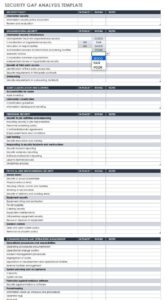Performing a requirements gap analysis is a great way to make sure that your software development project is successful and that the finished product meets the needs of your users. However, conducting a requirements gap analysis can be a complex and time-consuming process. That’s why it’s helpful to use a requirements gap analysis template.
A requirements gap analysis template provides you with a structured framework for identifying and documenting the gaps between the requirements of your software system and the capabilities of your existing system. A template can help you to ensure that you identify all of the relevant requirements and that you consider all of the potential options for addressing each gap.
How to Use a Requirements Gap Analysis Template
To use a requirements gap analysis template, you will need to first gather the following information:
- A list of the requirements for your software system
- A description of the capabilities of your existing system
- A list of the potential options for addressing each gap
Once you have gathered this information, you can begin to fill out the template. The template will typically include the following sections:
- Project overview: This section should provide a brief overview of your software development project, including the goals of the project and the target audience for the software.
- Requirements: This section should list the requirements for your software system. The requirements should be specific, measurable, achievable, relevant, and time-bound (SMART).
- Current capabilities: This section should describe the capabilities of your existing system. You should identify the areas where your existing system meets the requirements and the areas where it falls short.
- Gap analysis: This section should identify the gaps between the requirements of your software system and the capabilities of your existing system. The gaps should be documented in detail, including the source of the requirement, the impact of the gap, and the potential options for addressing the gap.
- Recommendations: This section should provide recommendations for addressing the gaps that have been identified. The recommendations should be specific and actionable.
Benefits of Using a Requirements Gap Analysis Template
There are several benefits to using a requirements gap analysis template. First, a template can help you to ensure that you identify all of the relevant requirements for your software system. Second, a template can help you to consider all of the potential options for addressing each gap. Third, a template can help you to document the results of your gap analysis in a clear and concise manner.
Overall, using a requirements gap analysis template can help you to improve the quality of your software development project and to ensure that the finished product meets the needs of your users.
Conclusion
Requirements gap analysis is a critical step in the software development process. By using a requirements gap analysis template, you can make sure that you identify and address all of the gaps between the requirements of your software system and the capabilities of your existing system. This will help you to deliver a software product that meets the needs of your users and achieves your business goals.
There are many different requirements gap analysis templates available online. You can choose a template that is specific to your software development project or you can create your own template. Regardless of the template that you choose, be sure to tailor it to your specific needs and to use it to identify and address all of the gaps in your software development project.


